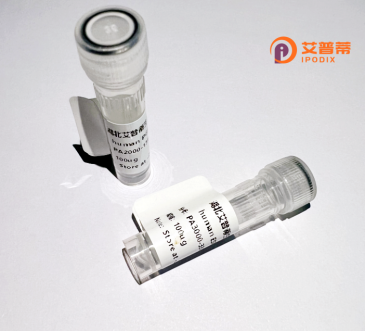
| 纯度 | >90%SDS-PAGE. |
| 种属 | Human |
| 靶点 | INPP4B |
| Uniprot No | O15327 |
| 内毒素 | < 0.01EU/μg |
| 表达宿主 | E.coli |
| 表达区间 | 1-53aa |
| 氨基酸序列 | MEIKEEGASEEGQHFLPTAQANDPGDCQFTSIQKTPNEPQLEFILDLNQELRD |
| 分子量 | 31.57 kDa |
| 蛋白标签 | GST-tag at N-terminal |
| 缓冲液 | 0 |
| 稳定性 & 储存条件 | Lyophilized protein should be stored at ≤ -20°C, stable for one year after receipt. Reconstituted protein solution can be stored at 2-8°C for 2-7 days. Aliquots of reconstituted samples are stable at ≤ -20°C for 3 months. |
| 复溶 | Always centrifuge tubes before opening.Do not mix by vortex or pipetting. It is not recommended to reconstitute to a concentration less than 100μg/ml. Dissolve the lyophilized protein in distilled water. Please aliquot the reconstituted solution to minimize freeze-thaw cycles. |
以下是关于重组人INPP4B蛋白的3篇参考文献概览:
---
**1. 文献名称**:*"INPP4B suppresses prostate cancer cell invasion"*
**作者**:Gewinner et al.
**摘要**:该研究通过表达重组人INPP4B蛋白,揭示了其在抑制前列腺癌细胞侵袭中的作用。实验表明,INPP4B通过拮抗PI3K/AKT信号通路,降低细胞内PIP3水平,从而抑制癌细胞迁移和转移潜能。
---
**2. 文献名称**:*"Structural and functional analysis of INPP4B phosphatase"*
**作者**:Campbell et al.
**摘要**:作者利用重组人INPP4B蛋白解析了其晶体结构,并阐明了其底物特异性机制。研究发现INPP4B通过独特的催化结构域选择性水解磷脂酰肌醇底物,为开发靶向INPP4B的癌症治疗方案提供了结构基础。
---
**3. 文献名称**:*"Recombinant INPP4B regulates chemoresistance in ovarian cancer"*
**作者**:Xie et al.
**摘要**:该研究通过体外表达纯化重组INPP4B蛋白,证明其过表达可逆转卵巢癌细胞对顺铂的耐药性。机制研究表明,INPP4B通过下调AKT/mTOR通路活性,增强癌细胞凋亡敏感性。
---
如需更多文献或特定方向研究,可进一步调整检索关键词(如结合特定疾病或信号通路)。
The inositol polyphosphate-4-phosphatase type II B (INPP4B) is a lipid phosphatase that hydrolyzes phosphatidylinositol-3.4-bisphosphate [PI(3.4)P2], negatively regulating the PI3K/Akt signaling pathway involved in cell proliferation, survival, and metabolism. Initially identified as a tumor suppressor, INPP4B is frequently deleted or downregulated in cancers such as breast, ovarian, and prostate cancer. Its loss enhances PI3K pathway activation, promoting oncogenesis, metastasis, and therapeutic resistance. However, INPP4B exhibits context-dependent roles; in PTEN-deficient tumors, it may paradoxically act as an oncogene by stabilizing Akt activation through alternative substrates. Structurally, INPP4B contains a catalytic domain and a C-terminal proline-rich region critical for protein-protein interactions. Recombinant human INPP4B protein is typically produced in mammalian or insect expression systems, preserving post-translational modifications and enzymatic activity. It serves as a key tool for studying phosphatase mechanisms, PI3K pathway dynamics, and cancer biology. Researchers utilize it to explore INPP4B's dual role in tumor suppression and progression, screen for modulators of its activity, or develop targeted therapies. Recent studies also link INPP4B to immune regulation and metabolic disorders, expanding its therapeutic relevance beyond oncology.
×